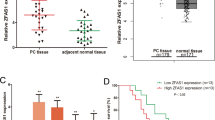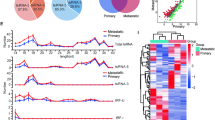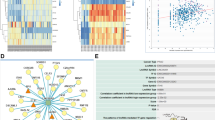Abstract
HOTAIR is a long intervening non-coding RNA (lincRNA) that associates with the Polycomb Repressive Complex 2 (PRC2) and overexpression is correlated with poor survival for breast, colon and liver cancer patients. In this study, we show that HOTAIR expression is increased in pancreatic tumors compared with non-tumor tissue and is associated with more aggressive tumors. Knockdown of HOTAIR (siHOTAIR) by RNA interference shows that HOTAIR has an important role in pancreatic cancer cell invasion, as reported in other cancer cell lines. In contrast, HOTAIR knockdown in Panc1 and L3.6pL pancreatic cancer cells that overexpress this lincRNA decreased cell proliferation, altered cell cycle progression and induced apoptosis, demonstrating an expanded function of HOTAIR in pancreatic cancer cells compared with other cancer cell lines. Results of gene array studies showed that there was minimal overlap between HOTAIR-regulated genes in pancreatic cells and breast cancer cells, and HOTAIR uniquely suppressed several interferon-related genes and gene sets related to cell cycle progression in pancreatic cancer cells and tumors. Analysis of selected genes suppressed by HOTAIR in Panc1 and L3.6pL cells showed by knockdown of EZH2 and chromatin immunoprecipitation assays that HOTAIR-mediated gene repression was both PRC2-dependent and -independent. HOTAIR knockdown in L3.6pL cells inhibited tumor growth in mouse xenograft model, further demonstrating the pro-oncogenic function of HOTAIR in pancreatic cancer.
This is a preview of subscription content, access via your institution
Access options
Subscribe to this journal
Receive 50 print issues and online access
$259.00 per year
only $5.18 per issue
Buy this article
- Purchase on Springer Link
- Instant access to full article PDF
Prices may be subject to local taxes which are calculated during checkout





Similar content being viewed by others
References
Mattick JS . Challenging the dogma: the hidden layer of non-protein-coding RNAs in complex organisms. Bioessays 2003; 25: 930–939.
Mattick JS . RNA regulation: a new genetics? Nat Rev Genet 2004; 5: 316–323.
Szymanski M, Barciszewska MZ, Erdmann VA, Barciszewski J . A new frontier for molecular medicine: noncoding RNAs. Biochim Biophys Acta 2005; 1756: 65–75.
Prasanth KV, Spector DL . Eukaryotic regulatory RNAs: an answer to the 'genome complexity' conundrum. Genes Dev 2007; 21: 11–42.
Perez DS, Hoage TR, Pritchett JR, Ducharme-Smith AL, Halling ML, Ganapathiraju SC et al. Long, abundantly expressed non-coding transcripts are altered in cancer. Hum Mol Genet 2008; 17: 642–655.
Guttman M, Donaghey J, Carey BW, Garber M, Grenier JK, Munson G et al. lincRNAs act in the circuitry controlling pluripotency and differentiation. Nature 2011; 477: 295–300.
Carthew RW, Sontheimer EJ . Origins and mechanisms of miRNAs and siRNAs. Cell 2009; 136: 642–655.
Borchert GM, Lanier W, Davidson BL . RNA polymerase III transcribes human microRNAs. Nat Struct Mol Biol 2006; 13: 1097–1101.
Pillai RS, Bhattacharyya SN, Filipowicz W . Repression of protein synthesis by miRNAs: how many mechanisms? Trends Cell Biol 2007; 17: 118–126.
Berezikov E, Plasterk RH . Camels and zebrafish, viruses and cancer: a microRNA update. Hum Mol Genet 2005, 14 Spec No. 2: R183–R190.
Lu J, Getz G, Miska EA, Alvarez-Saavedra E, Lamb J, Peck D et al. MicroRNA expression profiles classify human cancers. Nature 2005; 435: 834–838.
Nelson KM, Weiss GJ . MicroRNAs and cancer: past, present, and potential future. Mol Cancer Ther 2008; 7: 3655–3660.
Farazi TA, Spitzer JI, Morozov P, Tuschl T . miRNAs in human cancer. J Pathol 2011; 223: 102–115.
Rinn JL, Kertesz M, Wang JK, Squazzo SL, Xu X, Brugmann SA et al. Functional demarcation of active and silent chromatin domains in human HOX loci by noncoding RNAs. Cell 2007; 129: 1311–1323.
Khalil AM, Guttman M, Huarte M, Garber M, Raj A, Rivea Morales D et al. Many human large intergenic noncoding RNAs associate with chromatin-modifying complexes and affect gene expression. Proc Natl Acad Sci USA 2009; 106: 11667–11672.
Huarte M, Rinn JL . Large non-coding RNAs: missing links in cancer? Hum Mol Genet 2010; 19: R152–R161.
Spitale RC, Tsai MC, Chang HY . RNA templating the epigenome: long noncoding RNAs as molecular scaffolds. Epigenetics 2011; 6: 539–543.
Costa FF . Non-coding RNAs: meet thy masters. Bioessays 2010; 32: 599–608.
Huarte M, Guttman M, Feldser D, Garber M, Koziol MJ, Kenzelmann-Broz D et al. A large intergenic noncoding RNA induced by p53 mediates global gene repression in the p53 response. Cell 2010; 142: 409–419.
Gupta RA, Shah N, Wang KC, Kim J, Horlings HM, Wong DJ et al. Long non-coding RNA HOTAIR reprograms chromatin state to promote cancer metastasis. Nature 2010; 464: 1071–1076.
Tsai MC, Manor O, Wan Y, Mosammaparast N, Wang JK, Lan F et al. Long noncoding RNA as modular scaffold of histone modification complexes. Science 2010; 329: 689–693.
Yang Z, Zhou L, Wu LM, Lai MC, Xie HY, Zhang F et al. Overexpression of long non-coding RNA HOTAIR predicts tumor recurrence in hepatocellular carcinoma patients following liver transplantation. Ann Surg Oncol 2011; 18: 1243–1250.
Kogo R, Shimamura T, Mimori K, Kawahara K, Imoto S, Sudo T et al. Long noncoding RNA HOTAIR regulates polycomb-dependent chromatin modification and is associated with poor prognosis in colorectal cancers. Cancer Res 2011; 71: 6320–6326.
Stratford JK, Bentrem DJ, Anderson JM, Fan C, Volmar KA, Marron JS et al. A six-gene signature predicts survival of patients with localized pancreatic ductal adenocarcinoma. PLoS Med 2010; 7: e1000307.
Badea L, Herlea V, Dima SO, Dumitrascu T, Popescu I . Combined gene expression analysis of whole-tissue and microdissected pancreatic ductal adenocarcinoma identifies genes specifically overexpressed in tumor epithelia. Hepatogastroenterology 2008; 55: 2016–2027.
Collisson EA, Sadanandam A, Olson P, Gibb WJ, Truitt M, Gu S et al. Subtypes of pancreatic ductal adenocarcinoma and their differing responses to therapy. Nat Med 2011; 17: 500–503.
Baek SJ, Kim JS, Moore SM, Lee SH, Martinez J, Eling TE . Cyclooxygenase inhibitors induce the expression of the tumor suppressor gene EGR-1, which results in the up-regulation of NAG-1, an antitumorigenic protein. Mol Pharmacol 2005; 67: 356–364.
Baek SJ, Horowitz JM, Eling TE . Molecular cloning and characterization of human nonsteroidal anti-inflammatory drug-activated gene promoter. Basal transcription is mediated by Sp1 and Sp3. J Biol Chem 2001; 276: 33384–33392.
Wongthida P, Diaz RM, Galivo F, Kottke T, Thompson J, Pulido J et al. Type III IFN interleukin-28 mediates the antitumor efficacy of oncolytic virus VSV in immune-competent mouse models of cancer. Cancer Res 2010; 70: 4539–4549.
Numasaki M, Tagawa M, Iwata F, Suzuki T, Nakamura A, Okada M et al. IL-28 elicits antitumor responses against murine fibrosarcoma. J Immunol 2007; 178: 5086–5098.
Steen HC, Gamero AM . Interferon-λ as a potential therapeutic agent in cancer treatment. J Interferon Cytokine Res 2010; 30: 597–602.
Li M, Liu X, Zhou Y, Su SB . Interferon-lambdas: the modulators of antivirus, antitumor, and immune responses. J Leukoc Biol 2009; 86: 23–32.
Maia CJ, Socorro S, Schmitt F, Santos CR. . Characterization of oligoadenylate synthetase-1 expression in rat mammary gland and prostate: effects of 17β-estradiol on the regulation of OAS1g in both tissues. Mol Cell Biochem 2008; 314: 113–121.
Hatano H, Kudo Y, Ogawa I, Tsunematsu T, Kikuchi A, Abiko Y et al. IFN-induced transmembrane protein 1 promotes invasion at early stage of head and neck cancer progression. Clin Cancer Res 2008; 14: 6097–6105.
Haller O, Kochs G, Weber F . Interferon, Mx, and viral countermeasures. Cytokine Growth Factor Rev 2007; 18: 425–433.
Yu F, Ng SS, Chow BK, Sze J, Lu G, Poon WS et al. Knockdown of interferon-induced transmembrane protein 1 (IFITM1) inhibits proliferation, migration, and invasion of glioma cells. J Neurooncol 2011; 103: 187–195.
Zhang X, Lian Z, Padden C, Gerstein MB, Rozowsky J, Snyder M et al. A myelopoiesis-associated regulatory intergenic noncoding RNA transcript within the human HOXA cluster. Blood 2009; 113: 2526–2534.
Wang KC, Yang YW, Liu B, Sanyal A, Corces-Zimmerman R, Chen Y et al. A long noncoding RNA maintains active chromatin to coordinate homeotic gene expression. Nature 2011; 472: 120–124.
Wang KC, Chang HY . Molecular mechanisms of long noncoding RNAs. Mol Cell 2011; 43: 904–914.
Chintharlapalli S, Papineni S, Baek SJ, Liu S, Safe S . 1,1-Bis(3'-indolyl)-1-(p-substitutedphenyl)methanes are peroxisome proliferator-activated receptor gamma agonists but decrease HCT-116 colon cancer cell survival through receptor-independent activation of early growth response-1 and nonsteroidal anti-inflammatory drug-activated gene-1. Mol Pharmacol 2005; 68: 1782–1792.
Kim K, Chadalapaka G, Lee SO, Yamada D, Sastre-Garau X, Defossez PA et al. Identification of oncogenic microRNA-17-92/ZBTB4/specificity protein axis in breast cancer. Oncogene 2012; 31: 1034–1044.
Lei P, Abdelrahim M, Cho SD, Liu X, Safe S . Structure-dependent activation of endoplasmic reticulum stress-mediated apoptosis in pancreatic cancer by 1,1-bis(3'-indoly)-1-(p-substituted phenyl)methanes. Mol Cancer Ther 2008; 7: 3363–3372.
Jutooru I, Chadalapaka G, Lei P, Safe S . Inhibition of NFκB and pancreatic cancer cell and tumor growth by curcumin is dependent on specificity protein down-regulation. J Biol Chem 2010; 285: 25332–25344.
Simon R, Lam A, Li MC, Ngan M, Menenzes S, Zhao Y . Analysis of gene expression data using BRB-ArrayTools. Cancer Inform 2007; 3: 11–17.
Reich M, Liefeld T, Gould J, Lerner J, Tamayo P, Mesirov JP . GenePattern 2.0. Nat Genet 2006; 38: 500–501.
Eisen MB, Spellman PT, Brown PO, Botstein D . Cluster analysis and display of genome-wide expression patterns. Proc Natl Acad Sci USA 1998; 95: 14863–14868.
Acknowledgements
This research was supported by National Institutes of Health (CA136571) and Texas AgriLife.
Author information
Authors and Affiliations
Corresponding author
Ethics declarations
Competing interests
The authors declare no conflict of interest.
Additional information
Supplementary Information accompanies the paper on the Oncogene website
Supplementary information
Rights and permissions
About this article
Cite this article
Kim, K., Jutooru, I., Chadalapaka, G. et al. HOTAIR is a negative prognostic factor and exhibits pro-oncogenic activity in pancreatic cancer. Oncogene 32, 1616–1625 (2013). https://doi.org/10.1038/onc.2012.193
Received:
Revised:
Accepted:
Published:
Issue Date:
DOI: https://doi.org/10.1038/onc.2012.193
Keywords
This article is cited by
-
Current status of molecular diagnostic approaches using liquid biopsy
Journal of Gastroenterology (2023)
-
Long non-coding RNAs involved in different steps of cancer metastasis
Clinical and Translational Oncology (2022)
-
Neurospora crassa is a potential source of anti-cancer agents against breast cancer
Breast Cancer (2022)
-
Interruption of the long non-coding RNA HOTAIR signaling axis ameliorates chemotherapy-induced cachexia in bladder cancer
Journal of Biomedical Science (2022)
-
The lipid-lowering drug fenofibrate combined with si-HOTAIR can effectively inhibit the proliferation of gliomas
BMC Cancer (2021)



